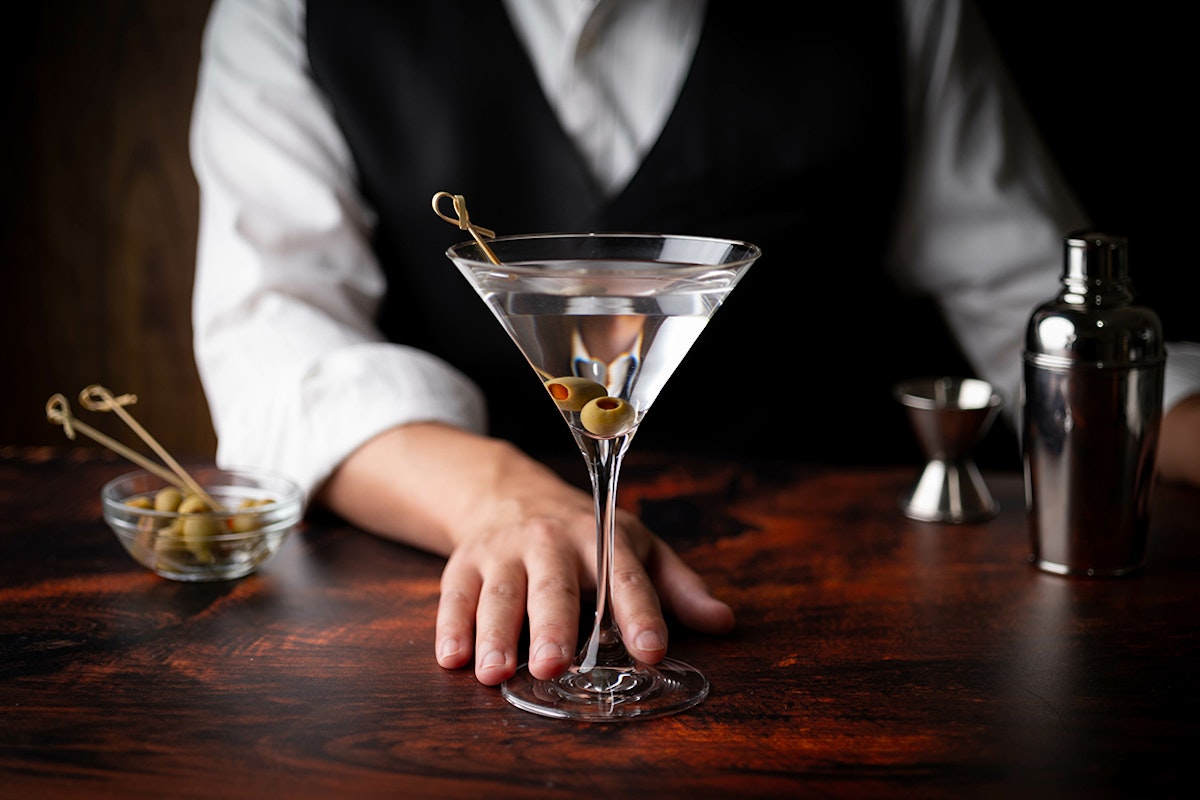Want to start an argument? Try telling someone the proper way to make a Martini. There are so many variables, from the shaken or stirred debate, to whether you should use gin or vodka. And don’t even get us started on the garnish. The Martini is such a personal cocktail with the best recipe determined by you and you alone. And that, of course, is why we love it.
ORIGINS OF THE MARTINI
Like so many classic cocktails, the exact origin of the Martini is lost to history. But one thing we do know is that it is a descendant of the Martinez cocktail, a drink first published in the late 19th century. The Martinez consists of Old Tom Gin*, sweet vermouth, Maraschino or Curaçao, and orange bitters. When London Dry Gin overtook Old Tom Gin in its popularity, this drier style of gin didn’t work in this somewhat sweet drink. Hence, the beginnings of a new cocktail.
*Old Tom Gin itself has no official regulations, but it is a slightly sweet gin which is sometimes aged for a brief amount of time. Flavorwise, it sort of lives in between Dutch Genever and London Dry Gin. There are a few Old Tom Gins on the market now to try such as Hayman’s Old Tom and Citadelle’s new No Mistake Old Tom Gin if you’re interested.
THE INGREDIENTS
An exact recipe is impossible to dictate (and fighting words to some). But the components themselves are: gin or vodka, dry vermouth, orange bitters (optional, but delightful), and a garnish of your choice.
As mentioned before, the Martini is a highly personal creation. A simple enough drink to make, but there are many things to consider before you begin. Think of it as the absolute best kind of Choose Your Own Adventure.

GIN OR VODKA
The biggest debate is which spirit to use, gin or vodka. Again, a personal decision and one which I feel both have its time and place. But of course, flavored vodkas are absolutely forbidden!
If you do use vodka, choose one you would drink neat since it will be the focus here. And if you’re going with vodka, consider whether you’d like a robust vodka such as Russian Standard or Ketel One or a more neutral expression like Absolut or Smirnoff.
As for the gin, again lots of different ways you can go. The most common selection would be a classic juniper-forward London Dry Gin such as Beefeater or Sipsmith. If you choose a more modern-style gin (ones where juniper takes a backseat), consider using less vermouth to let the highlighted botanicals in the gin shine. Examples would be Hendrick’s or Aviation Gin.
THE RATIO
First I’d like to mention that if you make a Martini without any vermouth you’re not drinking a Martini, you’re drinking chilled gin/vodka. No judgement here. I’ve enjoyed chilled vodka from time to time, but a Martini it is not.
Second, the ratio of gin or vodka to vermouth is highly subjective. Apparently Hemmingway liked his Martinis very dry with a 15 to 1 ratio (is there anything he DIDN’T drink?). Conversely, Julia Child liked hers inverted with a 1 to 5 ratio making her Martini considerably wet. Incidentally, an equal parts Martini is called a Fifty-Fifty and is a lovely preamble to dinner. And if you ask for a Perfect Martini, you’ll get one with equal parts dry and sweet vermouth.
But I digress. The best way to discover your prefered method is to be like Goldilocks, minus the breaking and entering part. Try and try again. Eventually you’ll find just the right one.
A good starting point to try:
– Four parts gin or vodka
– One part dry vermouth
– Dash of orange bitters

THE VERMOUTH
A word on the vermouth. If you can’t remember when you last bought your bottle of vermouth, toss it. Vermouth is an aromatized wine and although it is slightly fortified, like wine, it loses its freshness and can oxidize over time. If your household doesn’t use vermouth often, purchase small 375ml bottles and regardless of size, keep them refrigerated.
Not all vermouth is the same. There are sweet vermouths (reddish in color), dry vermouths (light yellow in color) and blanc/bianco (clear in color and slightly sweet). Dry vermouth is the standard for a Martini. Traditionally, French vermouths were dry and Italian vermouths were sweet. Of course vermouth brands nowadays make all styles. Make sure to read the labels! Try Dolin Vermouth de Chambéry Dry for your next Martini, especially if you’ve never had it.
SHAKEN OR STIRRED
James Bond shouldn’t dictate how you drink your Martini. Keep in mind what happens when you are making any cocktail. The idea is to chill, dilute, and mix your drink. When you shake a cocktail, you are adding texture to your drink with tiny air bubbles. This is good when you are mixing a cocktail with juice, dairy, or eggs. Generally if your cocktail doesn’t have any of those three ingredients, you would stir the cocktail.
Also, keep in mind shaking a Martini will make the drink appear cloudy. Additionally, small ice shards will appear on the surface of the drink. You may prefer that, just know why you’re doing it. I prefer mine stirred, mostly because I just love the process of it all. But again, no judgements if you like to shake.
THE GLASS
One thing you should do consistently regardless of how you take your Martini is to serve it ice cold. One way to do that is to keep your Martini glass in the freezer until you are ready to serve. Another way to chill your glass is to add ice and cold water into it while you are building your Martini. Then you can just dump the ice water prior to pouring in your Martini.
Most importantly, consider the SIZE of the Martini glass. Regardless of your Martini ratio, you should aim for no more than 7 oz glasses. Even better, use a 5 oz Nick and Nora glass, named for the lovely (drinking) couple in “The Thin Man” film series (1934-1947). The goal is to serve your Martini ice cold. It’s better to have several small cold Martinis than one giant warm one.
 Martini with cocktail onions (aka a Gibson Martini)
Martini with cocktail onions (aka a Gibson Martini)
THE GARNISH
Do you like your Martini served with a twist or an olive? Perhaps you take your Martini with a cocktail onion (in which case, you are drinking a Gibson). The choice is yours. Just make sure to state your preference when you order at the bar.
Speaking of the olive, let’s talk about the Dirty Martini. Some people turn their noses up, but a couple of bar spoons of olive brine is totally fine in my opinion. It’s best to keep the brine chilled just like you would with the olives. Since you’re going all out with the rest of your ingredients, do yourself a favor and try all types of olives, not just the “cocktail” ones. If you must have a blue cheese-stuffed olive, serve it on the side and not in the Martini. That’s a hill I’m willing to die on.
Ready to build your perfect Martini?
With Distiller, you’ll always know what’s in the bottle before you spend a cent. Rate, Review, and Discover spirits. Head on over to Distiller, or download the app for iOS and Android today!
Want to enjoy Distiller ad-free plus exclusive discounts, giveaways, features and other perks? Join Distiller Pro today to support the Distiller platform and keep ads off of your screen.


